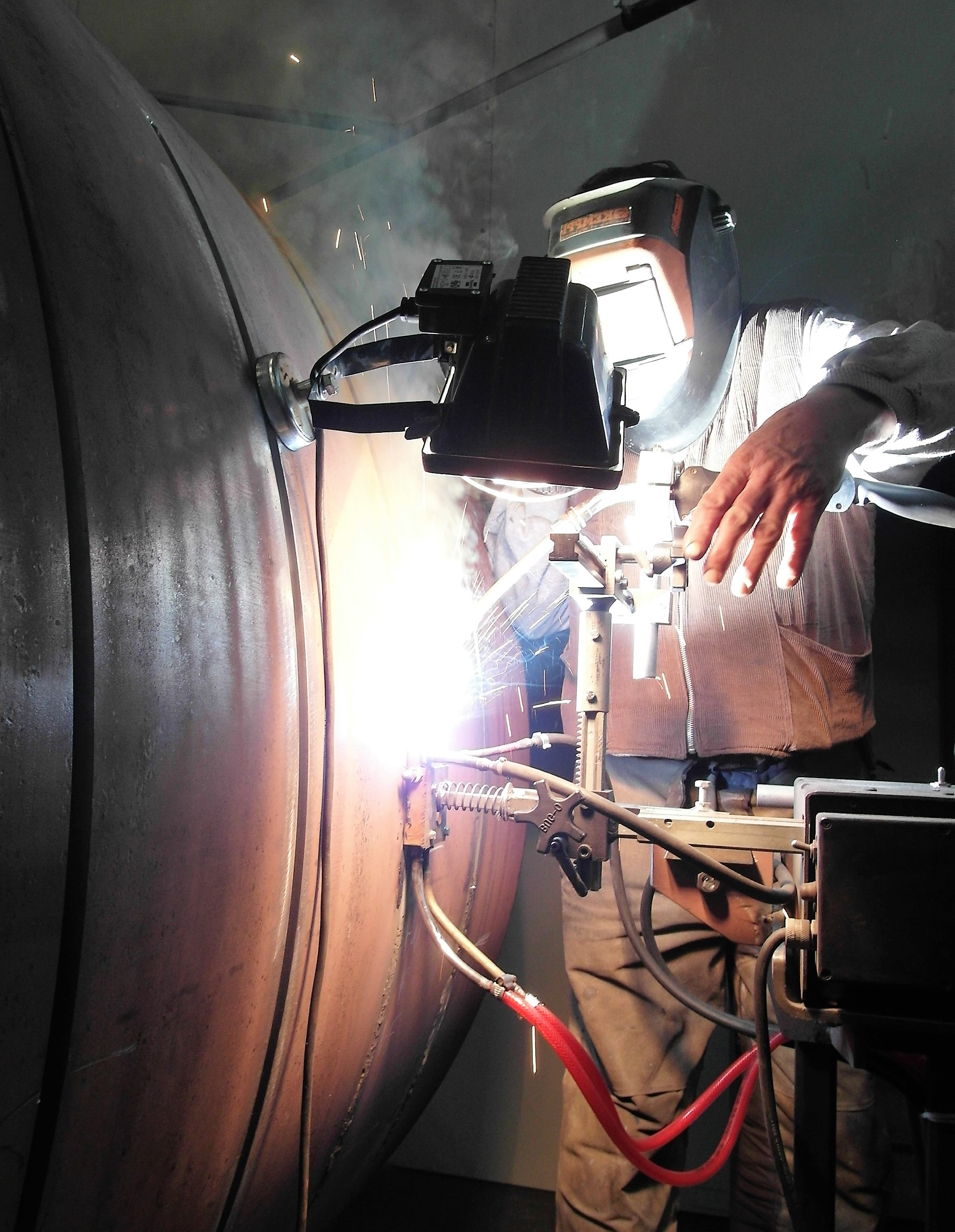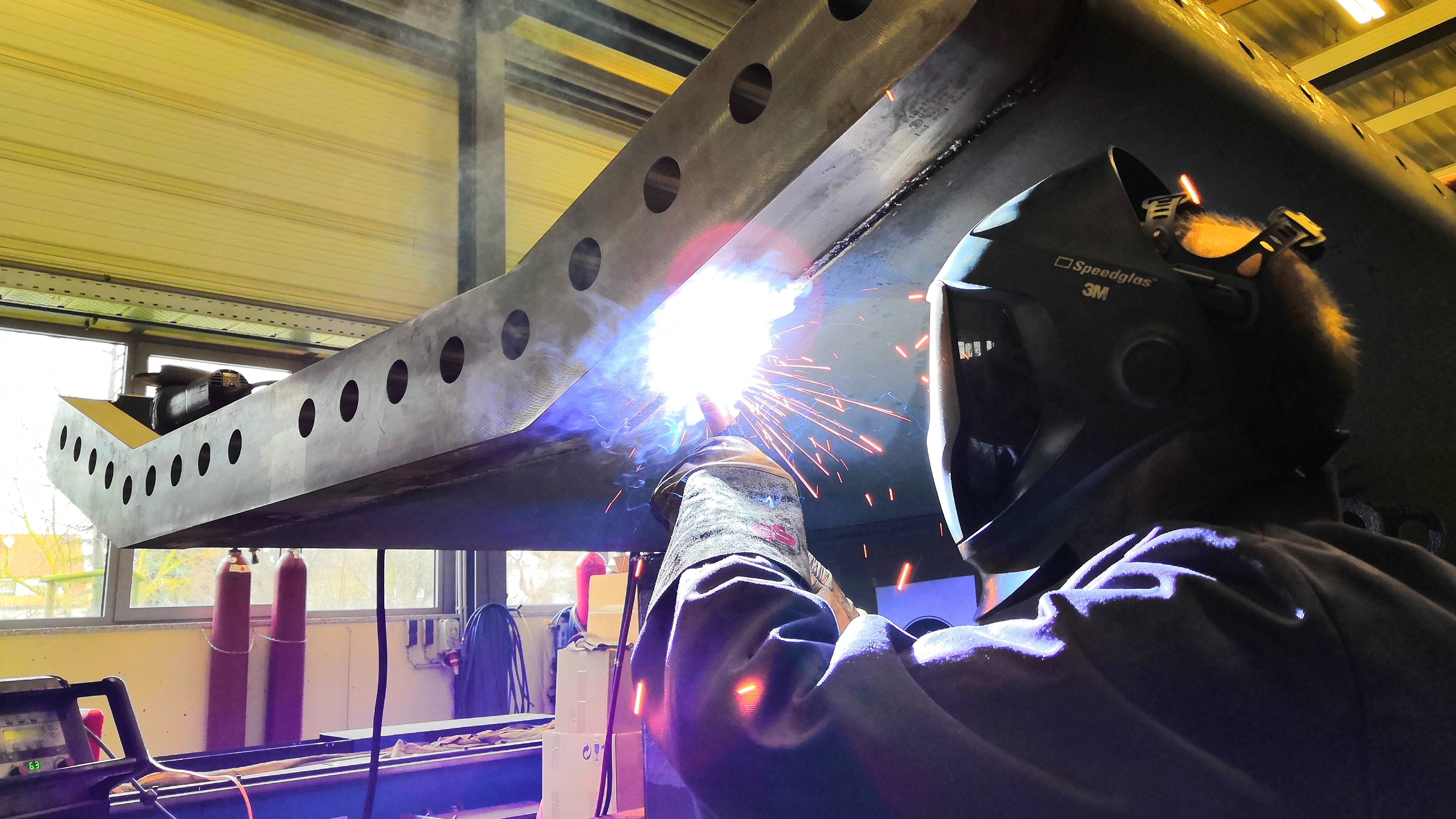Thermal Joining Engineering
Work area
Thermal cutting, coating and joining processes play a central role as value-added and quality determining manufacturing steps in a large number of production processes. In highly industrialised branches, welded joints and welding processes, in particular, have to satisfy constantly growing and changing demands with respect to cost-effectiveness, flexibility and quality.

These include, for example, high-quality processing of modern materials with often high demands on the mechanical and technological properties with consistent process reliability, the assurance of the part integrity of welded components of innovative lightweight steel constructions subject to high static and cyclic loads, increases in the cost-effectiveness of welding processes through modern automation solutions, and the introduction of highly productive welding methods to increase competitiveness as an answer to the growing pressure of costs in globalised markets.
In order to find long-term and sustainable solutions to the resulting technological and economic challenges, the Thermal Joining Engineering group at Fraunhofer IGP is continuously engaged in innovative research and development on current and future issues in the fields of shipbuilding, structural steel work, onshore and offshore wind energy. We always strive to holistically evaluate technological, metallurgical and design aspects of the respective welding applications within the value-added chain.
In 2020 the group changed its name. Welding Engineering has become Thermal Joining Engineering. Group Head Dr -Ing Andreas Gericke explains: „The change of name was necessary to communicate and represent our core area of welding technology as well as our other skills in the area of soldering and thermal spraying, which have grown sustainably and successfully over the years. In this way, we aim to be more visible to potential customers and continue strategic growth in these areas”.
Project overview
Welding under Water
Compensate for risks associated with wet welding under water
Induction heating engineering to improve the weld seam qualitiy for subsea welding of finegrain steels
The research project investigates the application of induction technology for pre- and post-heating in manual wet arc welding. Due to the influence of the media, there are high levels of hydrogen input and, due to the strong convection, high cooling rates after welding. As a result, critical material properties and cracks can result. The effective introduction of energy by means of induction is intended to be used for the practical compensation of subsea-specific risks during wet welding and consequently, also enabling the safe joining of high-strength steels. This is necessary for the economical and high-quality repair of structures in hydraulic steel engineering. Application guidelines for the use of induction heating engineering are in development.
Electroslag channel welding
Electroslag channel welding becomes plant-compatible
Development of a mobile electroslag (ES) channel welding system for construction site applications
The welding processing of thick-walled sheets is necessary for many constructions in the maritime sector in constrained positions and under construction site conditions. ES duct welding is a welding process for single- layer welding of vertical seam connections which is particularly economical and with low distortion. However, the inadequate level of knowledge about welding metallurgy and the lack of system technology mean that it is rarely used. The aim is therefore to develop a mobile ES duct welding system for use on butt and T-joints, as well as to adapt the system technology, welding engineering and welding metallurgy of ES duct welding to European manufacturing specifications.
Arc Brazing
Arc brazing as a substitute for welding in steel construction?
Use of arc brazing to join components on steel structures subject to high vibration levels
In steel construction, it is necessary to weld attachments without a primary load bearing function to structures subject to vibrational stress, which has an influence on the service life and design of high-strength steels. The project investigated whether arc brazing with copper-based solders is suitable for the substitution of welding processes in steel construction. The investigations show that the use of arc brazing to join attachments can extend the service life of the entire construction by up to 500% without the need for post-weld treatment. For example, there is a saving of 50 tonnes in weight on a tubular steel tower for wind turbines without reducing the static load-bearing capacity of the payload parts.
Temperature monitoring
An effective aluminium alloy straightening process
Non-contact temperature monitoring for qualifying the flame straightening of aluminium in shipbuilding
When joining aluminium, there is sometimes a great deal of distortion of the assemblies due to welding. In order to subsequently compensate for the distortion, straightening processes such as flame straightening are used. For steel constructions, annealing colours are used as a reference to estimate the temperatures required to achieve the desired straightening effect. This is not possible with aluminium, as annealing colours do not form in the relevant temperature range. The planned non-contact temperature monitoring system, which can be implemented in conventional straightening systems, is a basic requirement for increasing the reproducibility, reliability and degree of mechanisation in the flame straightening of aluminium, thus offering the possibility of qualifying the flame straightening process and expanding the business fields of interested SMEs.
Extension of the DASt Guideline 026
Extension of DASt-guideline 026
FAT-classification of HFMI-treated ultrahigh-strength structural steels considering geometric manufacturing imperfections in steel construction
In order to utilise the potential of high-strength steels for lightweight construction, the use of post-weld treatment processes is essential. In contrast to mechanical engineering, a regulatory basis for the use of corresponding procedures is necessary in the highly regulated field of construction. In this regard, DASt Guideline 026 enables the use of high frequency metal impact (HFMI) treatment processes as post-weld treatment methods in German steel construction. Currently, the guideline is restricted with regard to material strength and the applicability of the methods to constructions with geometric imperfections outside the usual limits. Based on the results of this project, the guideline shall be extended to allow the use of ultrahigh-strength materials and to specify how to address geometric imperfections.
Rotor bearing
Load testing of rotor bearings
Optimisation of rotor bearings with regard to corrosion resistance and fatigue strength
Thanks to the energy transition, wind turbines have become an indispensable part of modern power supply. The rotor bearings or rolling bearings are one of the most important components of such plants. The material used here must have a high degree of purity, hardness, wear and corrosion resistance in order to achieve the required load-bearing capacity and the longest possible service life. A general material characterisation with regard to the above-mentioned properties is the main component of this project and will be carried out according to the standards provided for this purpose. For the purpose of the load investigation, a mechanical-thermal coupled simulation model will also be created. This helps to determine the stress distribution and thus the geometric optimisation of the rotor bearing.
Kryomagan
Storage and transport of hydrogen
Processing boundary conditions and alloys of cryogenic raw materials as well as recommendations for processing strategies
The importance of LNG and hydrogen as fuel is growing strongly worldwide. Transport and storage often take place in the liquid state at cryogenic temperatures. For this purpose, steels with high nickel content are usually used. Due to the increased demands on low-temperature toughness, the materials used are reaching their limits. One approach to solving this problem is the use of new types of medium- and high-manganese steels. However, there are currently no reliable welding processing instructions to bring these materials into widespread use for the growing market in storage/transport of cryogenic raw materials. Therefore, medium and high manganese steels will be investigated in this project and recommendations on processing strategies, modified filler materials and work safety will be developed.
additive manufacturing technologies
MarKomp
Generative manufacturing of maritime components
The development of new manufacturing technologies is opening up new perspectives for the production of components for maritime systems. Additive manufacturing (AM) technologies have developed rapidly not only because of their ability to produce near-net-shape components with complex geometries, but also because they offer various advantages over conventional processes in the area of individual component production. As part of the current research project, in addition to the development of a robot-assisted machining cell and the design of the ship's propeller suitable for production, an adapted hybrid process chain is to be developed so that large-format components can be manufactured additively while ensuring high manufacturing accuracy and freedom from defects.
GMA Welding
Inert gas metal arc welding with the aid of artificial intelligence
Project: Intelligent processing of arc signals to prevent process irregularities in MSG welding
In steel construction, joining long joints using MSG welding is a labour-intensive and time-consuming production step. Mobile welding carriages are often used here with the aim of increasing productivity with reproducibly high seam quality. In practice, however, weld defects and process instabilities often occur for various reasons, e.g. varying seam preparation. The aim is therefore to develop an algorithm and control system that detects and prevents process instabilities in mechanised MSG welding before they occur. For this purpose, a prognosis model is to be developed, which serves as a reference variable for a downstream control system.
Services
- Application-oriented development and optimisation of thermal joining and cutting processes
- Determination of mechanical-technological and fracture-mechanical material, joint and component properties (e.g., destructive tests on welds acc. to ISO 4136, ISO 5178, ISO 9015, ISO 9016, ISO 9017, ISO 9018, ISO 15653, etc.)
- Analysis of welding processes by combined optical, electrical and thermal measuring methods
- Development and qualification of economical methods for improving the fatigue strength of welded structures
- Development and qualification of welding and soldering additives
- Chemical analyses (spark emission spectrometry, carrier gas extraction to determine O, N, H content in various metals, energy dispersive X-ray spectroscopy EDX)
- Structural analysis and feature determination of Fe, Cu, Al and Ni-based materials by means of light and scanning electron microscopy (SEM)
- Determination of welding-related distortion as well as of residual stress states and development of countermeasures
- Automation of welding processes and development of monitoring systems
- External and construction supervision with mobile measuring and analysis technology
- Design and dimensioning of welded and soldered joints
- Welding technology, metallurgical and construction consultancy
- Development testing and inspection of subsea connection technologies
- FE simulation of welding processes, numerical distortion simulation
- Technical damage analysis and consultation on failure prevention (metallic materials) – failure analysis
Equipment
Welding laboratory
- Submerged arc tandem double wire welding machine
- Electro gas welding machine
- Robot gantry with adaptive welding and cutting device
- Submerged arc manual welder
- various MSG, plasma, TIG, autogenous welding and cutting equipment
- Heat treatment furnaces
- autogenous preheating system
- div. measuring equipment (high speed camera, thermography, process parameter, etc.)
- induction heat technology
- various stud welding equipment
- collaborative robot (Cobot) welding
Analytical laboratory
- OES device/arc spark spectrometry (chemical analysis)
- metallography (preparation and analysis) (e.g. acc. to ISO 17639)
- reflected and transmitted light microscopes
- Ultrasonic testing device
- ONH analyzer
- Hydrogen analysis (e.g., acc. to ISO 3690)
- Hardness tester and instrumented indentation testing (Nanoindentation)
- ESPI residual stress tester
- micromagnetic measurement methods (3MA technology)
 Fraunhofer Institute for Large Structures in Production Engineering IGP
Fraunhofer Institute for Large Structures in Production Engineering IGP